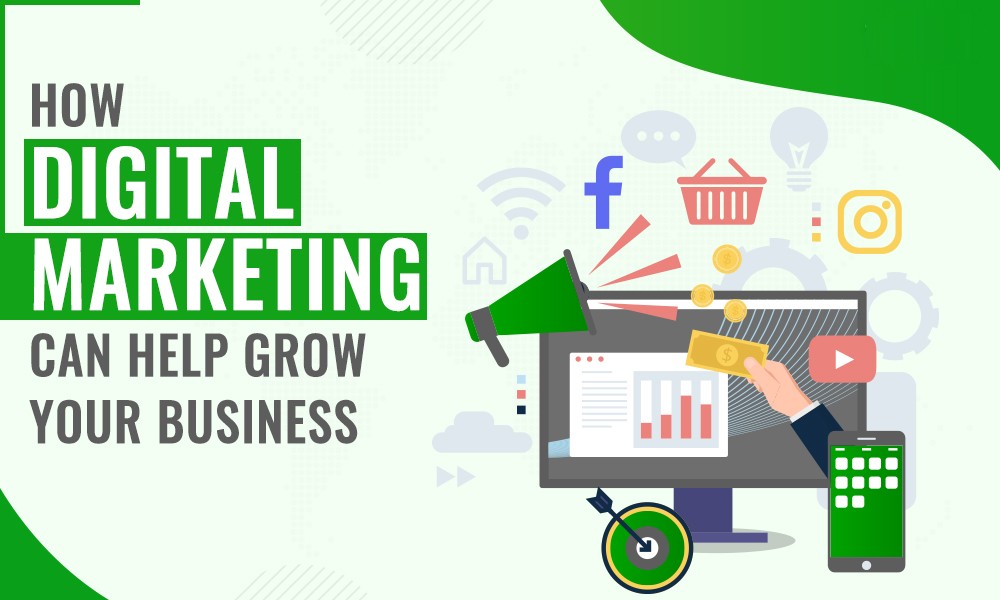Table of Contents
In today’s fast-paced digital landscape, traditional marketing methods alone are no longer sufficient for business growth. With the increasing reliance on technology and the internet, digital marketing has become an indispensable tool for business growth. Leveraging various online channels and strategies, digital marketing offers businesses a cost-effective and efficient way to reach their target audience, engage with customers, and drive sales. In this comprehensive guide, we’ll explore the myriad ways digital marketing can help you grow your business and provide actionable insights to maximize your online presence.

Understanding Digital Marketing
Digital marketing encompasses a wide range of tactics aimed at promoting products or services through digital channels. These channels include websites, search engines, social media platforms, email, mobile apps, and more. Unlike traditional marketing, digital marketing allows for precise targeting, real-time tracking, and personalized communication, making it an invaluable tool for businesses of all sizes.
1. Enhancing Brand Visibility with Search Engine Optimization (SEO)
In the vast ocean of the internet, standing out from the competition is essential. This is where Search Engine Optimization (SEO) comes into play. SEO is the process of optimizing your website to rank higher in search engine results pages (SERPs) for relevant keywords and phrases. By optimizing your website’s structure, content, and metadata, you can improve its visibility and attract more organic traffic.
Key strategies for effective SEO:
- Keyword Research: Identify relevant keywords and phrases that your target audience is searching for. Use tools like Google Keyword Planner, SEMrush, or Ahrefs to discover high-volume keywords with low competition.
- On-Page Optimization: Optimize your website’s title tags, meta descriptions, headings, and content to include your target keywords naturally. Ensure your website is user-friendly, mobile-responsive, and loads quickly to provide a seamless browsing experience.
- Quality Content Creation: Publish high-quality, informative content that addresses the needs and interests of your target audience. Incorporate keywords strategically, and regularly update your content to keep it fresh and relevant.
- Link Building: Build backlinks from authoritative websites in your industry to enhance your website’s credibility and authority in the eyes of search engines. Focus on acquiring natural, high-quality backlinks through guest blogging, influencer outreach, and content partnerships.

2. Engaging with Your Audience Through Content Marketing
Content is king in the digital realm. Content marketing involves creating and distributing valuable, relevant content to attract and engage your target audience. Whether it’s blog posts, videos, infographics, or podcasts, compelling content can drive traffic to your website, increase brand awareness, and foster customer loyalty.
Tips for Effective Content Marketing:
- Understand Your Audience: Research your target audience’s demographics, interests, and pain points to tailor your content accordingly. Create buyer personas to better understand their needs and preferences.
- Diversify Your Content: Experiment with different formats and mediums to keep your audience engaged. Mix written content with visuals, videos, and interactive elements to cater to diverse learning styles.
- Consistency is Key: Establish a consistent publishing schedule to keep your audience informed and engaged. Whether it’s weekly blog posts, monthly newsletters, or daily social media updates, maintain a regular cadence to stay top-of-mind.
- Promote Your Content: Don’t just publish content and hope for the best. Actively promote your content across various channels, including social media, email newsletters, and online communities. Encourage sharing and engagement to amplify your reach.
3. Leveraging Social Media Marketing for Brand Awareness
With billions of active users worldwide, social media platforms have become indispensable marketing channels for businesses. Social media marketing involves creating and sharing content on social networks to build brand awareness, drive website traffic, and engage with your audience on a more personal level.
Best Practices for Social Media Marketing:
- Choose the Right Platforms: Identify which social media platforms your target audience frequents and focus your efforts on those channels. Whether it’s Facebook, Instagram, Twitter, LinkedIn, or TikTok, tailor your content to suit each platform’s unique audience and features.
- Create Compelling Visuals: Social media is a visual medium, so invest in high-quality images, videos, and graphics to capture your audience’s attention. Use eye-catching visuals that align with your brand identity and messaging.
- Encourage Engagement: Foster two-way communication with your audience by asking questions, soliciting feedback, and responding to comments and messages promptly. Encourage user-generated content and create interactive experiences to keep your audience engaged.
- Track and Analyze Performance: Use social media analytics tools to track the performance of your posts, campaigns, and overall social media presence. Identify which content resonates most with your audience and adjust your strategy accordingly.
4. Harnessing the Power of Email Marketing for Business growth
Email marketing remains one of the most effective channels for nurturing leads, building relationships, and driving sales. With targeted email campaigns, you can deliver personalized messages directly to your subscribers’ inboxes, keeping them informed about your latest products, promotions, and updates.
Strategies for Successful Email Marketing:
- Build a Quality Email List: Focus on building a permission-based email list of subscribers who have opted in to receive communications from your brand. Offer incentives such as discounts, freebies, or exclusive content to encourage sign-ups.
- Segment Your Audience: Divide your email list into segments based on demographics, purchase history, or engagement level. Tailor your email content and offers to each segment’s specific interests and needs to maximize relevance and effectiveness.
- Craft Compelling Emails: Write clear, concise, and compelling subject lines and email copy that entices recipients to open and engage with your emails. Use personalized greetings, dynamic content, and persuasive calls-to-action to drive conversions.
- Automate and Optimize: Take advantage of email marketing automation tools to streamline your workflow and send targeted, timely emails based on user behavior and triggers. Test different email elements such as subject lines, send times, and content to optimize performance and drive results.
Conclusion
In today’s digital age, businesses must embrace digital marketing strategies to stay competitive and drive growth. By leveraging the power of SEO, content marketing, social media, and email marketing, you can expand your online presence, engage with your audience, and ultimately, achieve your business objectives. Remember, digital marketing is not a one-size-fits-all solution, so experiment with different tactics, measure your results, and continuously refine your approach to achieve optimal results. With the right strategy and execution, digital marketing can propel your business to new heights in the digital landscape.
